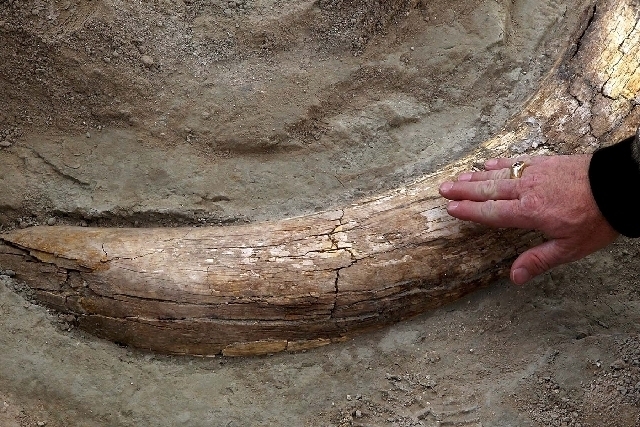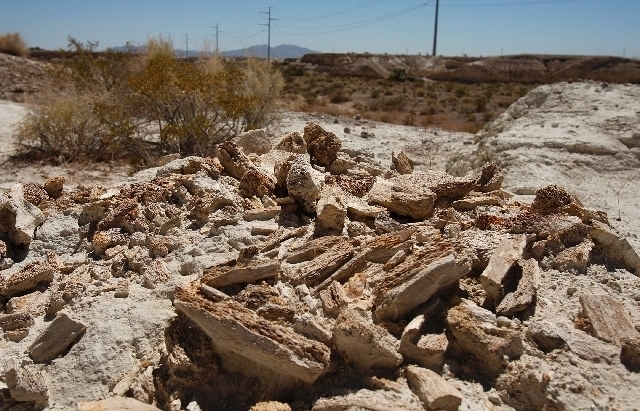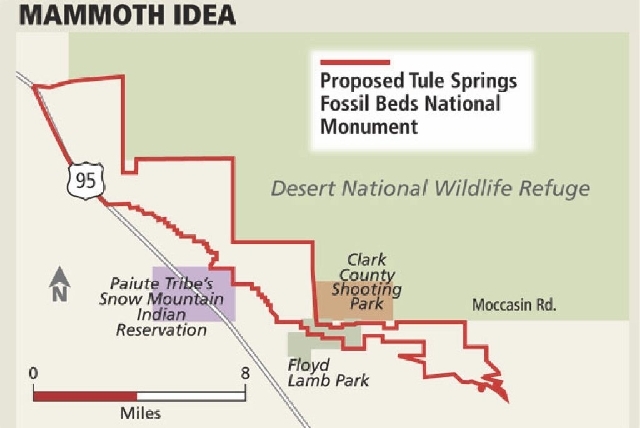Ice age fossil beds at Tule Springs could get ‘national monument’ designation
For the second time in less than a year, Nevada lawmakers in Congress are pushing for a new national monument to protect thousands of ice age fossils hidden in the hills at the northern edge of Las Vegas.
A bill introduced Thursday would create Tule Springs Fossil Beds National Monument on roughly 22,650 acres.
The measure mirrors a proposal introduced in the previous Congress in June. The legislative session ended before the bill could advance.
Nevada’s newest — and right now only — national monument would border the cities of Las Vegas and North Las Vegas, the Las Vegas Paiute Indian Reservation and the Desert National Wildlife Refuge.
The sawtooth-shaped patch of desert once considered for sale to developers is littered with the bones of mammoths and other extinct animals that lived and died between 10,000 and 250,000 years ago.
Researchers continue to pull ice age specimens from the chalky hills along the Upper Las Vegas Wash, which could hold more than 10,000 fossils by some estimates.
Within the past year, scientists have found rare remnants of two Pleistocene predators: a saber-toothed cat and a dire wolf.
“We continue to find things,” said geologist and paleontologist Kathleen Springer, who leads a team from California’s San Bernardino County Museum that is collecting fossils under a contract with the U.S. Bureau of Land Management. “There’s a lifetime of work to be done.”
The land is also home to several rare plant species.
Conservationists who have long fought to preserve the area heralded the return of the legislation, but they didn’t get everything they wanted.
The Protectors of Tule Springs and other groups had hoped to block a plan by NV Energy to build a new power line across the land, which is also home to several rare plant species.
Instead, the bill designates a corridor, under the jurisdiction of the BLM, for a transmission line that will be primarily used to carry renewable energy.
The rest of the monument would be managed by the National Park Service.
Every member of Nevada’s congressional delegation signed onto the Las Vegas Valley Public Lands and Tule Springs Fossil Beds National Monument Act, which was reintroduced in both the House and Senate on Thursday.
They even issued a shared written statement on the bill.
“Tule Springs will become a hotbed of research, education, and tourism for our state,” said Democratic Rep. Steven Horsford, who toured the area earlier this year. “We owe it to future generations to protect this area and designate it as America’s newest national monument.”
Republican Sen. Dean Heller said he was pleased that the measure balances conservation with economic development and public access. “Considering 87 percent of Nevada’s land is federally owned, I’ve consistently made it a top priority to balance Nevadans’ needs.”
In addition to creating the national monument, the legislation would carve out 2,410 acres of federal land for the expansion of campuses within the Nevada System of Higher Education, while adding some property to Red Rock Canyon National Conservation Area and beefing up management of the Spring Mountain National Recreation Area.
Also under the bill:
■ Nellis Air Force Base would get 410 acres for training and other use near its small-arms range.
■ A 10,000-acre block in the Nellis Dunes, between the Air Force base and Apex, would be designated as a recreation area for off-road vehicles, with Clark County getting 1,211 acres of that land to establish a park for off-roaders.
■ The county would get another 2,320 acres near Primm to build flood protections for the proposed Ivanpah regional airport.
■ North Las Vegas would get land for commercial development.
But Tule Springs is the main thrust of the bill.
For researchers like Springer, it’s gratifying to see a national monument proposed almost entirely for scientific reasons.
What makes the area special, she said, is its combination of diverse fossils in a unique — and uniquely datable — geologic setting that offers researchers a rare glimpse into how long-extinct animals responded to changes in climate.
“There really is so much more that can be done and will be done if this monument designation goes through,” Springer said. “With Fossil Beds National Monument, you’re not just preserving the animals. It’s about preserving the whole enchilada through a quarter of a million years of time.”
Contact reporter Henry Brean at hbrean
@reviewjournal.com or 702-383-0350.



















